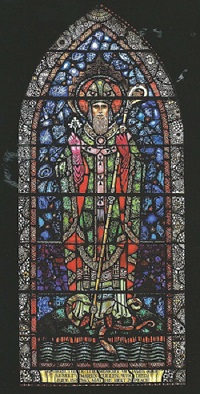
The Saint Patrick Window from the Harry Clarke Studios (1943) in the Church of St Thomas, Callow, Killasser, County Mayo. It shows him holding the shamrock and teaching about the Trinity.
Saint Patrick was a fifth-century British-born missionary bishop, who is chiefly credited with the conversion of the then pagan Irish to Christianity. Several holy people in early Christian Ireland who devoted their lives to spreading the faith and founding churches were often described as saints (it was many centuries later before the formal church process of canonization was introduced). Nevertheless, Patrick is venerated as a saint in the Catholic Church, the Church of Ireland, and other churches. Saint Patrick’s Day, March 17, the date on which he is believed to have died (but the year in uncertain), is celebrated by Irish people at home and around the world in honour of Ireland’s patron saint. It is believed that the first St Patrick’s day parade was held in Boston in 1779, now a big feature of the day everywhere, with the biggest every year in New York City. It is now customary for the Irish taoiseach to visit Washington DC on St Patrick’s Day and present a bowl of shamrock to the President of the United States. March 17 became a Catholic Church holiday in Ireland in the seventeenth century, and a public holiday in 1900.
Christianity was introduced to Ireland at the start of the fifth century, if not earlier, and Pope Celestine appointed Palladius as first bishop to the Irish Christians, but it is Saint Patrick who is credited with the spread of Christianity in Ireland. According to his own writings, he came from an ecclesiastical family in Britain and that his father was named Calpurnius, a deacon in the church. After capture by Irish raiders at the age of sixteen, Patrick was sold into captivity herding sheep on the slopes of Slemish mountain in County Antrim. There, he spent many hours in prayer, which was critical to his spiritual development. After six years, he escaped and returned home. He later said that in a dream he heard ‘the voices of the Irish’ asking him to return. After ordination at Auxerre in France he was appointed as bishop of the Irish and returned to Ireland. His early years in Ireland as a missionary bishop were in the north and, according to various accounts written in the seventh century, as first bishop he made Armagh the capital of his Irish church (to this day it is the capital of both Catholic Church and the Church of Ireland in the country, with both cathedrals there named in his honour). He appears to have spent some time in County Mayo in the west of Ireland, including, according to legend, forty days and nights on the summit of Croagh Patrick, fasting and praying for the people of Ireland. Other Patrician sites recorded for the county include Aghagower near Westport, Ballintober, Kilmoremoy, near Ballina, and various parts of north Mayo as far west as Ballycastle.
Saint Patrick is said to have baptised thousands, ordained many priests, and became the chief evangelizer of the natives, bringing Ireland within the See of Rome and part of universal Christendom. Saint Patrick is associated with the shamrock, because it is said that he used a three-leafed shamrock to explain the concept of The Holy Trinity (three persons in one God, The Father, The Son and The Holy Spirit). The shamrock became an Irish symbol. He also lit a paschal fire on the hill of Slane in County Meath in defiance of the local high king. The legend that he drove all the snakes from Ireland is a fallacy, as there were never snakes in the country.
St Patrick wrote two concise documents in Latin, his autobiographical Confessio and his Letter to the Soldiers of Coroticus. These were the earliest writings to be penned in Ireland, and they are preserved in manuscripts that are kept in Continental libraries, although an abbreviated version of the Confessio is found in the Book of Armagh, an early ninth-century manuscript, now in the library of Trinity College, Dublin. A text written in the late seventh century by Bishop Tírechán, from Tirawley in north Mayo, suggested that the area west of Killala was the location of Silva Vocluti, ‘the wood of Fochluth beside the western sea’ mentioned by Patrick in his Confessio.
It is believed that St Patrick died at Saul, in County Down, and that he was buried nearby in the grounds of Down Cathedral at Downpatrick.
